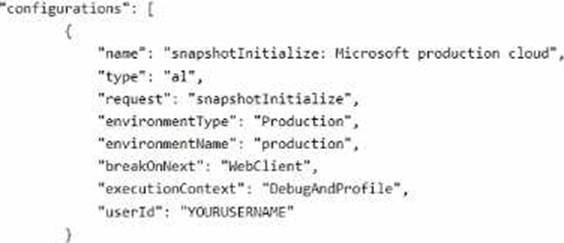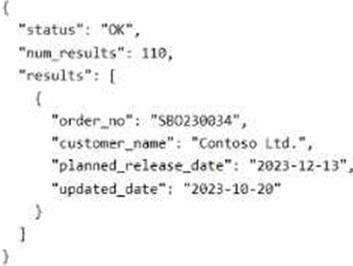- All Exams Instant Download
Which three actions should you perform in sequence?
Topic 2, Contoso, Ltd.
Overview
Contoso, Ltd. Is a sales company in the manufacturing industry. It has subsidiaries in multiple countries/regions, each with its own localization. The subsidiaries must be data-independent from each other. Contoso. Ltd. uses an external business partner to manage the subcontracting of some manufacturing items. Contoso. Ltd. has different sectors with data security between sectors required. Contoso, Ltd. uses Business Central online as the main ERP for financial. sales, purchase, warehouse, and manufacturing processes. It has employees that use the Business Central web application and external applications. The company has a custom external mobile app under development
The IT department and its partners installed custom extensions to satisfy the company’s requirements where the functionality is not available natively.
Contoso. Ltd. interacts with external services provided by customers and partners. Different applications interact with SOAP and OData endpoints exposed from Business Central.
An external business partner of Contoso, Ltd exposed a REST API for receiving details about new subcontracting orders and for sending the planned release date of each subcontracting order received.
Contoso. Ltd. has not activated the monitoring of the tenant and has no internal telemetry for its apps.
Custom reporting must be created to meet the requirements of the different departments.
Contoso, Ltd. has the following tenant management considerations:
IT department
• The IT department requires the ability to monitor the tenant to prevent performance problems and detect possible anomalies.
• The IT department plans to use Azure Application Insights and Log Analytics to inspect the ingested telemetry signals.
• All tenant upgrades are automatically handled by Microsoft. The IT department does not check for update availability or for tenant-related notifications.
• The IT department has not configured the receipt of tenant-related notifications from the Business Central admin center.
External business partner
• The external business partner must add custom telemetry to an application created for Contoso. Ltd. to monitor a business process.
• Custom telemetry signals for the application must be visible only on the partner’s telemetry.
SOAP
• Contoso, Ltd. plans to dismiss using the SOAP protocol for integrations.
• Contoso, Ltd. must be able to detect if external applications are using its Business Central SOAP endpoints.
Issue
The Business Central tenant is upgraded by Microsoft to a new major version during the night.
Users report that one of the Contoso. ltd. extensions disappeared from the tenant The IT department confirms that the extension is still published.
Contoso. Ltd. plans to create a custom mobile application that has the following requirements:
• The app must be used by employees to check item details from the ERP in real time and to report issues that occur during the manufacturing process.
• An AL extension must be created for handling archived issues.
• Business Central development guidelines must be followed when implementing modules.
• A module must be implemented for the reporting and tracking of issues information. You plan to call this module Issue Management The module must expose a method nan Postlude.
• Code modifications will be required over time.
• The Issue Management process must be split into two extensions: o ISSUE BASE: main extension
o ISSUE EXT: second extension with dependency from ISSUE BASE
• In the version 1.0.0.0 of the ISSUE BASE extension, you plan to create an Issue table that contains a global Decimal variable named Issue Total.
• In the version 1.0.0.0 of the ISSUE BASE extension, you plan to define a table named Issue Category with a Description field defined as follows:
field (2; Description; Text[SG])
{
DataClassificstion * CustoaerContent;
>
• The Issue table defined in ISSUE BASE extension contains a Clone procedure defined as follows: procedure Corte () begin end;
• In the ISSUE EXT extension, you create a table extension object of the Issue table.
• The table extension object of the Issue table must access the Issue Total: Decimal variable. After weeks of usage, you discover that you must remove the Description field and the Clone procedure because they are no longer required.
In a new version of the ISSUE BASE extension, you create a new Issue Type table. You must move data row by row from a previously obsolete Issue Category table to the new Issue Type table. Because a large amount of data must be moved, you must write an Upgrade codeunit by using the DataTransfer object.
The IT department creates a custom API for exposing the custom Issue table. The API provides an action for copying an issue to a new table. The action is defined as follows:
(Service Enabled]
procedure Copy (vary action Context: WebServiceActionContext) begin
end;
Contoso, Ltd. must create an API in Business Central to expose item details to the mobile application.
• The API must have the lowest possible impact on the production environment when used during working hours.
• The API must only support Get operations.
A user of the ISSUE BASE extension in Business Central reports a problem.
To debug the problem, snapshot debugging with the following configuration was activated:

You discover that the debugging is not triggering.
Contoso, Ltd. must connect Business Central to the external API provided by the business partner. This will be used for the partner to send the details of new subcontracting orders to fulfill the sales demand, and for receiving the planned release date of each order sent.
The integration requirements are as follows:
• The business partner will provide a REST API secured with basic authentication. Credentials to access the API will be shared with Contoso, ltd.
• The API for sending subcontracting orders must be called by sending an authenticated POST request to the given endpoint.
• The API for retrieving the order no. and planned release date of each subcontracting order responds with the following JSON:

Each order no. must be retrieved.
DRAG DROP
You need to handle the removal of the Description field and the Clone procedure without breaking other extensions.
Which three actions should you perform in sequence? To answer, move the appropriate actions from the list of actions to the answer area and arrange them in the correct order. NOTE: More than one order of answer choices is correct. You will receive credit for any of the correct orders you select.

Answer: 
Explanation:
In Business Central, when you need to handle the removal of fields and procedures to ensure that other extensions are not affected by these changes, you typically follow a two-step deprecation process. This allows other developers and users to adapt to the changes before they are fully enforced.
Here are the steps to handle the removal:
Mark as Obsolete: In the first version where the decision to remove the field or procedure is made, you set the ObsoleteState to Pending and provide an ObsoleteReason. This doesn’t remove the feature but indicates to users and developers that it will be removed in the future. This step is crucial for backward compatibility.
Removal: In a subsequent version, after users have had time to adapt to the deprecation warning, you can then remove the field or procedure or set the ObsoleteState to Removed.
Based on these guidelines, here are the three actions you should perform in sequence:
Set the Description field as ObsoleteState = Pending and ObsoleteReason = ‘Not in use’ in version 2.0.0.0.
Set the Clone procedure as ObsoleteState = Pending and ObsoleteReason = ‘Not in use’ in version 2.0.0.0.
Remove the Description field from the Issue table in version 2.0.0.1.
These steps will ensure that anyone using the Description field or Clone procedure will receive a warning about the pending deprecation before it is actually removed, thereby minimizing the impact on other extensions and providing a clear path for migration.
When handling the removal of fields and procedures in Microsoft Dynamics 365 Business Central, the process should be carried out in a way that allows other extensions or dependent features to adapt to the changes without causing immediate failures.
Set Obsolete State and Reason for Description Field (Version 2.0.0.0): The first step involves marking the Description field as obsolete by setting the ObsoleteState to ‘Pending’. This is a non-breaking change, signaling to other developers and users that the field is planned for removal in a future version. An ObsoleteReason should also be provided to explain why the field is being deprecated. Set Obsolete State and Reason for Clone Procedure (Version 2.0.0.0): Similarly, the Clone procedure should be marked as obsolete with the ObsoleteState set to ‘Pending’. This indicates that the procedure is no longer in use and will be removed in the future. Providing an ObsoleteReason is best practice as it explains the rationale behind the decision.
Remove the Description Field (Version 2.0.0.1): In the subsequent version, after the developers and users have been given time to adapt to the deprecation notice, the Description field can be safely removed from the Issue table. This is considered a breaking change, hence it is done after the field has been marked as obsolete in a previous version.
The reason for not removing the Description field and Clone procedure immediately in version 2.0.0.0 is to avoid causing runtime errors for any extensions or integrations that may depend on these components. By following this sequence, you provide a clear deprecation path that helps maintain the stability of the overall system while evolving the schema.
Latest MB-820 Dumps Valid Version with 56 Q&As
Latest And Valid Q&A | Instant Download | Once Fail, Full Refund
Subscribe
Login
0 Comments
Inline Feedbacks
View all comments

